Puff Pastry Dough Recipe
Having an easy puff pastry dough recipe under your belt can really help out if you are interested in doing a lot of French food preparation. It seems that puff pastry, which is called pâte feuillettée, just keeps popping up. You will find it used to make innumerable appetizers and desserts and it might also make appearances throughout a meal. It can be the crust of a savory tart or quiche, stacked into a cylinder to make vol au vents, or even just used by itself as a small decoration, known as a fleuron.
Traditional Pâte Feuilletée
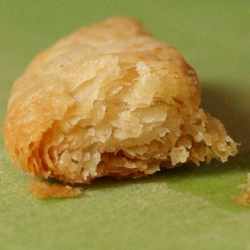
Traditionally puff pastry is made with a simple dough of flour, water and salt (called la détrempe) that is rolled out and then topped with butter. The dough is then folded and rolled out several more times, requiring refrigeration between each rolling. This creates layers of butter alternating with layers of dough, which will eventually give the baked pastry its crispy, puffy texture.
This method can be a little daunting for the average home cook and it is certainly time consuming. For a long time, I opted to buy ready made crusts and just avoid the hassle which always seemed to threaten when I thought of puff pastry. However, one always sacrifices a little when using ready made shortcuts. They are never as good as homemade and if you have a perceptive palate, you may detect a slight chemical taste no matter how good the product.
The Easy Puff Pastry Dough Recipe
Fortunately there is another solution. The puff pastry dough recipe here calls for quickly blending all of the ingredients, including the butter, in a food processor. You then roll and fold the dough just like in the traditional puff pastry dough recipe, but you no longer need to fuss with refrigeration between the rolling and folding. Because it is frozen, the butter remains separate from the dough and you will get an effect very like a traditional pâte feuilletée. Perhaps a professional baker would never consider such a method, but for me the results are just fine.
After I discovered this easy way to make a decent puff pastry, I have never gone back to store bought. It does require a little bit of planning since the butter needs to be frozen before you prepare the dough. When I am planning my weekly menu, I will note any pastry looming on the horizon and freeze the butter at the start of the week. Freezing just the amount called for to make one crust in separate containers makes things even easier.
There are two important rules you must follow to have success with this puff pastry dough recipe. (Believe me, these are not my favorite kitchen rules, but tasty food does have its price.)
Precision. Measure ingredients precisely. It is especially important to get the flour to water ratio correct. I have given the weight measurements as well as the cup measurements below. If you have a kitchen scale, please use it. Weighing ingredients always gives better results.
Speed. Move through the recipe quickly. No lollygagging or the butter will start to soften and meld with the dough and the puff pastry effect will be lost. The dough requires a strong arm to roll out because the butter is frozen, so roll up your sleeves and get a work out.
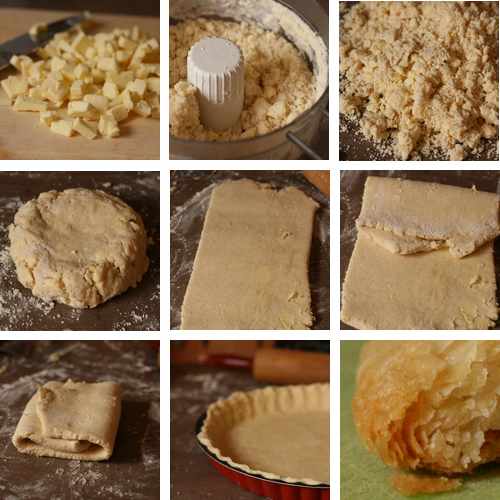
Ingredients
- 150 grams unsalted butter (5 1/2 ounces or 11 tablespoons)
- 150 grams all purpose flour (5 1/2 ounces or 1 cup)
- 75 grams water (a little less than 3 ounces or approximately 1/3 cup)
- 3/8 teaspoon salt
Directions
- Cut the butter into about 150 more or less evenly sized pieces. Wrap closely in plastic wrap or a freezer bag and freeze for at least several hours (longer is fine).
- Place the frozen butter, flour, water and salt in the bowl of a food processor and process for 15 seconds, or just until the flour and water are mixed together.
- Turn the dough (which will be quite lumpy and in pieces) onto a lightly floured surface. Quickly gather the dough into a rectangular mass about 10 x 20 centimeters (4 x 8 inches).
- Using a lightly floured rolling pin roll the dough out into a rectangle about 15 x 30 centimeters (6 x 12 inches), with the shorter side facing you. Fold the bottom edge up to 1/3 from the top, and fold the top edge down on top of this. Turn the dough 1/4 turn and roll it out again to about the same size. Once again fold and turn the dough. Continue rolling out, folding and turning the dough two more times, so that in the end you have rolled it out four times.
- Fold and gather the dough one final time trying to approximate the shape you wish to achieve with the final product - ie a disc if you are aiming for a circle, a boxy shape for a square or rectangle, etc.
- At this point you can roll the dough into whatever shape you wish. Refrigerate the shaped dough for at least 20 minutes before preceding with your recipe.
Yield: This recipe makes 375 grams (14 ounces) of dough or enough for one 25 centimeter (10 inch) round tart pan.
Freezing: Puff pastry can be shaped and frozen for later use. Defrost in the refrigerator before using or you can blind bake it directly from the freezer.
Blind baking: Preheat oven to 200°C (400°F). Bake for 20 to 25 minutes depending on size of pastry and your oven.
Reheating: Puff pastry is always best warm. You can bake it ahead of time and rewarm it in the oven for a few minutes.
Using Puff Pastry
Now that you have your puff pastry dough recipe, what are you going to make?
Here are some ideas of how you might find it served in France: allumettes, bouchées, dartois, galettes, mille-feuilles, palmiers, tartes, vol-au-vent, and more!
Return from puff pastry dough recipe to French pastry recipes.
Explore more French recipes.
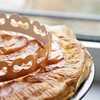
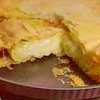
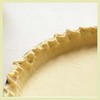
New! Comments
Have your say about what you just read! Leave me a comment in the box below.